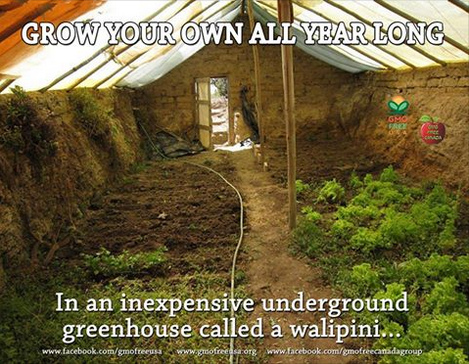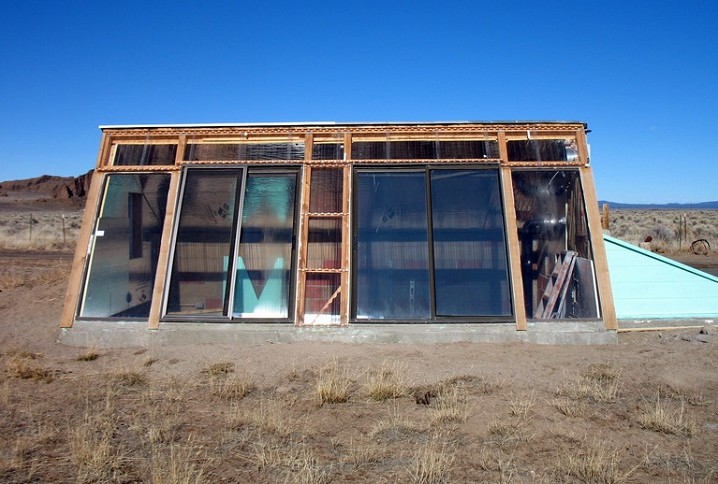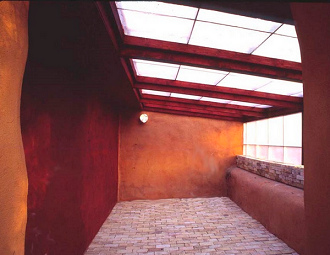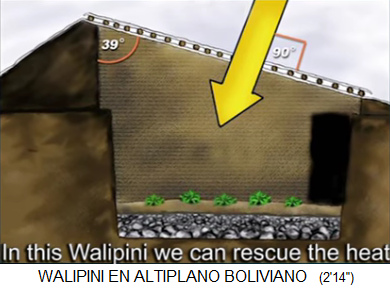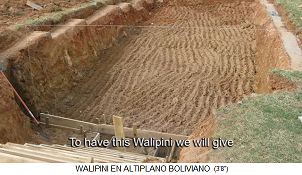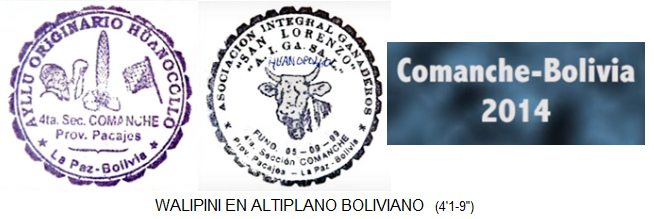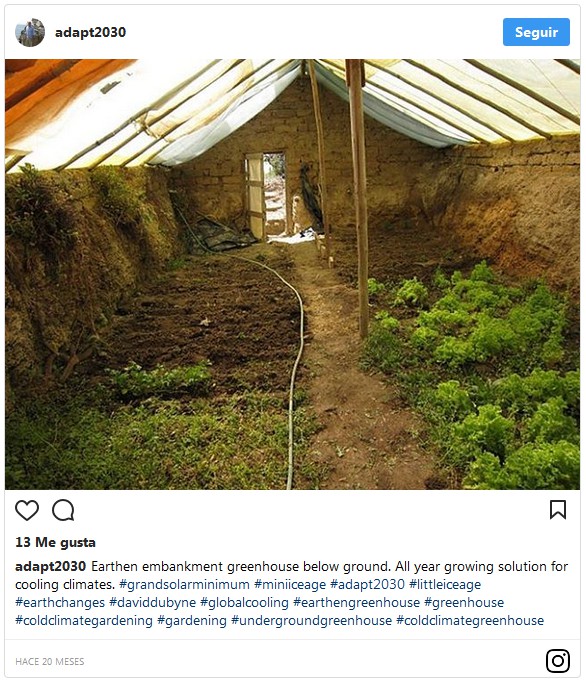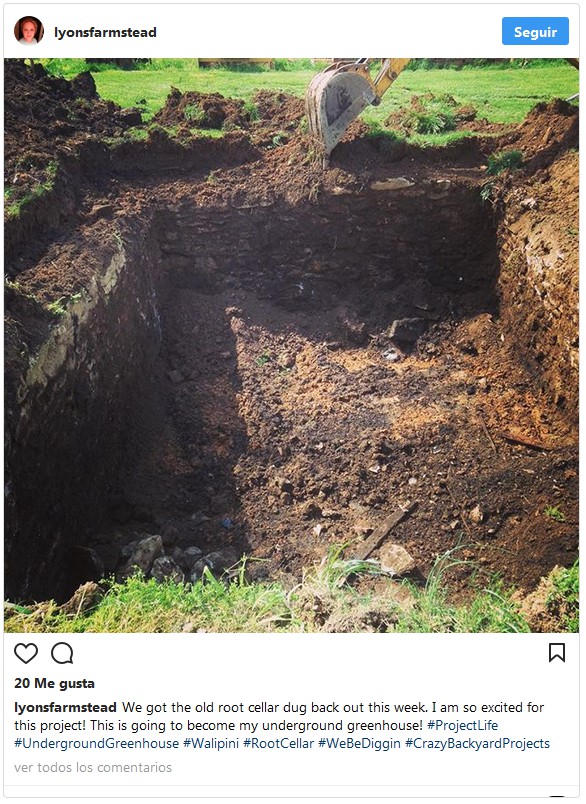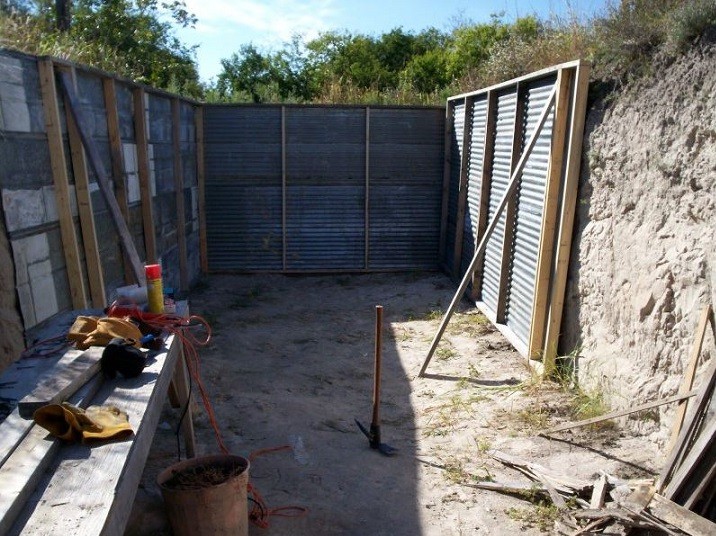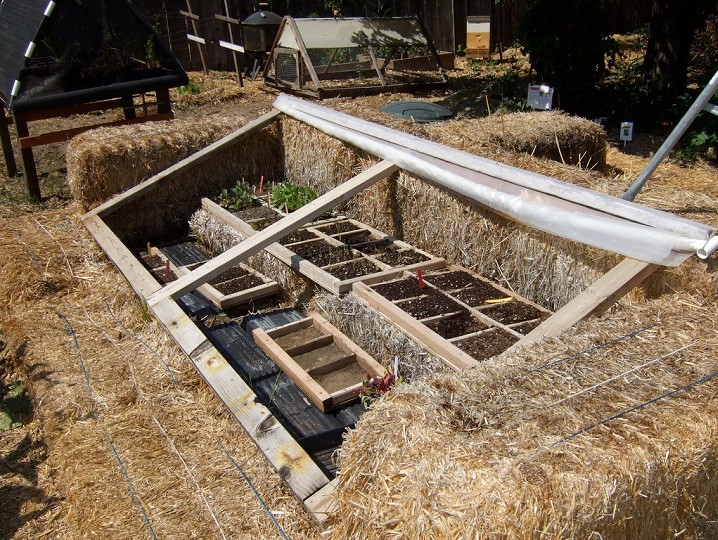D - ESP
<< >>
Agriculture: organic permaculture 4a7: "Walipini" - pit greenhouse for ALL SEASONS
With Walipini, EACH COUNTRY can run its OWN agriculture ALL YEAR LONG: free standing, on a slope
NO pesticides - NO machines - NO long transports - NO overuse of water reserves in warm regions for plantations etc.
MINIMUM energy consumption - Mother Earth has it!
presented by Michael Palomino (2018)
| Share: |
Facebook |
|
Twitter
|
|
|
|
Literature
-- James McCullagh: The Solar Greenhouse Book - edition: Rodale press
-- Mike Oehlers: The Earth Sheltered Solar Greenhouse Book
Tricks for pit greenhouses -- Pit greenhouse "Walipini" with a V roof -- Buildings half underground have their big advantage due to thermal inertia --
1) Greenhouses with V pitched roof (very vulnerable to hail) --
2) Pit greenhouses with a fixed roof and steep window fronts (hardly susceptible to hail) Tube pit greenhouse with rigid roof and steep window front by Roald Gundersen, Wisconsin ("USA") --
3) Slope pit greenhouses (hail protection 100%) 3a) Walipini: slope pit greenhouse (embankment greenhouse) in Tennessee ("USA") -- 3b) Walipini: Slope greenhouse (pit greenhouse on the slope) with cold sink - scheme -- 3c) Walipini: Slope greenhouse (pit greenhouse on the mountainside) -- 3d) Slope greenhouse (pit greenhouse on an embankment) in Bozeman (Montana, Canada) with cold air ditch and water barrel heating --
4) Added pit greenhouses attached to the residential homes -- 4a) Cultivated pit greenhouse with arched roof by Rob Stout, Embudo, New Mexico ("USA") -- 4b) Cultivated mine greenhouse with full glazing in white -- 4c) Attached pit greenhouse with full glazing in black --
5) Straw ball greenhouses / hothouses --
Links about pit greenhouses -- Best books with instructions for building of pit greenhouses / pit hothouses -- More sources about pit greenhouses / pit hothouses -- Pit greenhouse, video -- Nov. 4, 2015: Build yourself a frost free underground greenhouse
High Andes 25-07-2017: agriculture in the high mountains is possible with pit greenhouses "Walipini"
www.facebook.com/gmofreeusa
www.gmofreeusa.org
In areas with cold winters, the construction of a pit greenhouse with a V-roof, a tube pit greenhouse with a solid roof and a steep window front, or a greenhouse sunk into the mountain slope (slope greenhouse) is worthwhile. The greenhouses with V-roof have the greatest hail susceptibility, the pit greenhouses being sunk into a mountain slope are the safest.
Bolivia in the highlands at 4000m above sea level: Walipini is a semi-subterranean pit greenhouse with geothermal energy, where it never gets below 0 degrees [1]
Tricks for pit greenhouses
1. The microclimate in pits is stable because the soil layer is reacting slowly to climate change: Due to the thermal inertia, the deep soil is always moderately warm in winter and moderately cool in summer, because the soil layer takes several months to adapt to the outside temperature.
2. 1.2m: The minimum depth of a pit greenhouse is 1.2m.
3. Wall materials: Wall material may be: earth, earth bricks, natural stones, earth bags, water barrels.
4. The walls become a heating battery: the walls store the heat and radiate the heat during the night, therefore it's never too cold during the night, in other words: the earth walls work like a battery and give off the warmth during the night.
5. Heating from 5 sides: there are 4 heated walls and the heated floor during the night: The heating during the night comes from 5 warm sides: 4 warm walls and the warm floor - in a normal greenhouse there is only 1 warm side: the floor.
6. Heating with water barrels at the back side: This is the best heating method in a Walipini greenhouse because water stores warmth the longest and radiates it the longest during the night, but the water barrels need more space.
7. Watering with rainwater in water barrels: rainwater can be collected in the water barrels.
8. Watering of plants with rainwater: When the water barrels are full one can install an additional water tank for watering the plants with living water.
9. Build 1m above the groundwater level: Pit greenhouses must be built at least 1 m above the groundwater level, otherwise a major water damage is possible.
10. Window front greenhouse: window front towards the sun: The window front of a window front greenhouse must always be directed to the sunny side: In the northern hemisphere, the window front is facing south, and the back wall (north wall) takes most of the heat. In the southern hemisphere, the windows face north and the back wall (south wall) stores most of the heat.
11. Window front angle: The angle of the main window side is optimal with a 90 degree angle to the sun during the winter solstice - or the window side is shaped in the shape of a half U, which corresponds to every possible sun angle.
12. Small windows for ventilation: The window front has small windows for ventilation possibilities during summer times.
13. Window materials / transparent roofing materials: Windows are made of glass or plexiglass (four-layered polycarbonate sheets) with a thickness of 7/8". The plexiglass is then bendable to form half a U.
14. The tube pit house: The longer a pit greenhouse is (a tube pit greenhouse), the warmer it will be and the more stable the temperature is at night. At the same time, a pit greenhouse must have no holes at night to keep the cold air out.
15a. Roofs (transparent): may be in the form of a V (glass, plexiglass) or in the form of a U (plexiglass). Plastic wrap is TOXIC, releases microplastic through weathering and is poisoning the air and everything.
15b. Roofs (solid) can be a normal roof combined with a window front to the sunny side, or the roof can be on a mountainside the mountain itself combined with a window front to the sunny side.
16. Plastic film / foil / wrap is poisonous because the weathering causes microplastics to be released into the air and the air and everything is poisoned.
17. Water circle, drainage, ventilation: Everything must be watertight, there must be no holes in the structure, there must be drainage, and for summer there must be ventilation or windows to open.
18. Avoid hail damage with chicken wire: Glass roofs can be protected with chicken wire. When the roof is solid in combination with a windows front one can attach a small "canopy" with chicken wire so there will never be any hail damage.
Do not use plastic sheeting: do not use plastic foil / film / wrap because weathering causes the sheeting to constantly release microplastics into the air and the air and all is poisoned. A plastic sheet is weathering within in 3 to 4 years.
Reports about pit greenhouses
Pit greenhouse "Walipini" with a V shaped roof
Pit greenhouse. The inside can be clad with stone, mudbrick or any dense natural material that can absorb large amounts of heat to release the heat during the night, so it never gets too cold at night. Cool weather crops such as lettuce, kale and broccoli can be grown in harsh climates in winter. The glazing creates a "greenhouse effect". In order to avoid problems with the groundwater, a pit greenhouse should be built at least 1m above the groundwater level.
For hail protection a protection chicken wire should be installed over the roof.
Pit greenhouse in Spetchley Gardens, UK. Stairs down to the entrance on the right. Picture of Mezzapod via Flickr.
During the day, the earth walls store the heat. The walls are like a battery, giving off their heat at night. A properly designed pit greenhouse is naturally heated at night from five sides. In an above-ground greenhouse, only one side, the ground, is warmed up during the day. A pit greenhouse Walipini is like a watertight battery. Here are more plans.
Slope pit greenhouse: Greenhouse half sunk in a slope (slope greenhouse) with earth brick floor.
This earth-walled, sunken greenhouse is built with lots of natural clay to absorb the heat. The two most important factors in a pit greenhouse are the large amount of thermal mass (thick walls of stone, of earth, or water barrels) and the orientation of the window front to the sun. About organica.net.pl
For hail protection, one should cover large glass roof areas with a chicken wire.
The most important fact about pit greenhouses and lowered pit buildings:
Buildings half underground have their big advantage due to thermal inertia
(original Spanisch: Edificios semienterrados: beneficios de la inercia térmica)
[web03] https://faircompanies.com/articles/edificios-semienterrados-beneficios-de-la-inercia-termica/
Translation:
<by Nicolás Boullosa - Feb. 20, 2013
Whether houses or greenhouses, half sunk buildings benefit from the thermal resistance, of the energy and of cooling of the earth and make life easier for people and plants in areas with high temperature fluctuations and unexpected climatic events.
Such houses are more and more often used as greenhouses because this thermally comfortable microclimate is very good for crops, humans and animals: in winter there is warmth, in summer there is cool feeling, and there is no use of energy for this, but energy of the earth mass is used.
Exploitation of the constant temperature of the earth
In semi-concealed buildings, the indoor temperature remains constant and corresponds to the annual average local air temperature. This is possible thanks to the thermal inertia of the earth in the underground building area, whose reaction to the outside temperature is delayed by several months, and thus there are no changes of temperatures during some cold winter months or some hot summer months.
Natives knew always about this pit earth climate: to avoid thermal fluctuations, it is sufficient to lower the floor of the building (and thus further away from the surface).
Bioclimate: from luxury to the necessary technology
Partially sunk buildings follow simple construction techniques and bring immediate yields. The benefits which had the ancestors is becoming important again as any protection from extreme disasters and phenomenons as Hurricane Sandy are becoming always more important.>
Examples of pit greenhouses
An underground greenhouse is called Walipini in South "America". The word comes from the language of the Aymara aborigines and means "place of warmth".
When digging, the top layer of soil is carefully preserved, because it later becomes the floor of the greenhouse. The earth of the deeper soil layer is attached to the shadow side as a wall on the shadow wall.
The inclination of the windows is optimal when the angle to the sun is 90 ° during the winter solstice, because then the energy is stored in the pit when the sun shines the least
1) Greenhouses with V pitched roof (very vulnerable to hail)
1a) Walipini from LaPaz, Bolivia
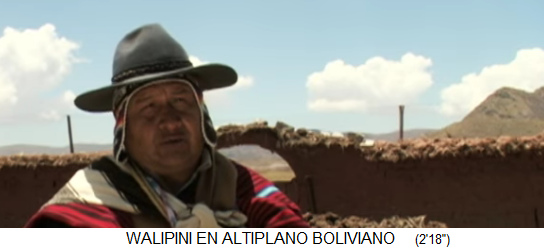
Farming in Bolivia at an altitude of 4000m, many pit hothouses (Walipinis) are said to improve food safety. Overall, it only rains in Bolivia for 3 months. - Walipini, a pit greenhouse from Bolivia, cross section

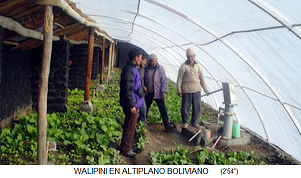
Walipini: Half sunken greenhouse with transparent film roof, Bolivia - Walipini, half sunken greenhouse in a slope with transparent plastic tarpaulins to the sunny side - Walipini under construction, the pit with the walls, Bolivia - plastic sheet is bad for microplastic in the air, better is plexiglass or glass.
The stamps at the end of the movie, Bolivia
Walipini: Earthen embankment greenhouse below ground. All year growing solution for cooling climates,
A pit greenhouse is a great help to separate plants from the harsh outside world, so that the gardeners can harvest all year round. -
https://twitter.com/adapt2030?lang=es
In hail areas, the roof must be covered with a chicken wire so that large hailstones can not reach the transparent roof.
1b) Walipini: The construction of a stable V-roof with transparent corrugated roof
Construction of a roof of a pit greenhouse (Walipini) with stable, transparent corrugated plastic elements
This is a stable plastic roof which holds snow masses and big hail balls. But it's plastic and not so good - better plexiglass.
The corrugated plastic elements last about 4 years in frosty areas, then they become fragile.
1c) Walipini: Here a garden pit greenhouse is being installed
Walipini under construction, from an old cellar the ceiling is removed and earth is installed.
On this site, the owners begin to build their underground hothouse. An excavator will be used for this, and soon the shell is ready.
1d) Walipini in a hard ground like sandstone, Texas
A pit greenhouse (Walipini) in a sandstone soil, Texas
This pit greenhouse is located in Texas, in fact it's a hole dug into the ground. Here the ground was as hard as sandstone. The image was originally at https://taroandti.com. listed.
2. Pit greenhouses with a fixed roof and steep window fronts (hardly susceptible to hail)
Tube pit greenhouse with rigid roof and steep window front by Roald Gundersen, Wisconsin ("USA")
The tube formed greenhouse by Roald Gundersen in Wisconsin. The greenhouse is 2800 square feet (s.f.) - and is insulated with straw bales. The support structure is made of Robinia wood, grows fast, is robust, rot-proof, and is abundant in Wisconsin.
Susceptibility to hail damage is minimal.
The interior view of the tubular pit greenhouse of Roald Gundersen in Wisconsin ("USA"). The larger a pit greenhouse, the more efficient it is because the temperatures in a small greenhouse fluctuate faster.
Links:
https://www.motherearthliving.com/green-homes/deeprootsstrongbranches?slideshow=3
https://www.finehomebuilding.com/2013/06/25/meet-the-timber-truss
3) Slope pit greenhouses (hail protection 100%)
3a) Walipini: slope pit greenhouse (embankment greenhouse) in Tennessee ("USA")
A Walipini hothouse is installed halfway in the hill, Tennessee
This hothouse is built into a hill.
3b) Walipini: Slope greenhouse (pit greenhouse on the slope) with cold sink - scheme
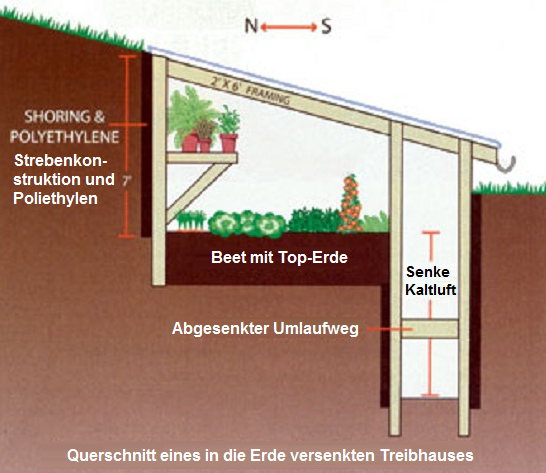
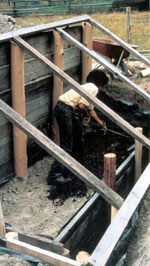
The picture shows the design for a slope greenhouse by Mike Oehler. He adds a cold-air ditch to the greenhouse on the mountainside. So he can water the plants and harvest the plants while standing.
Website of Mike Oehler: Build an Earth-Sheltered, Energy-Efficient Greenhous. Triple the length of your growing season with this simple, energy-efficient greenhouse design.
Book by Mike Oehler: The Earth Sheltered Solar Greenhouse Book
3c) Walipini: Slope greenhouse (pit greenhouse on the mountainside)
Walipini, pit greenhouse on the mountainside with window front to the sunny side
Many owners of greenhouses store the rainwater on the back wall as water for watering, and for additional heat storage. The entrance of this slope greenhouse is on the right side.
3d) Slope greenhouse (pit greenhouse on an embankment) in Bozeman (Montana, Canada) with cold air ditch and water barrel heating
Here is another possible combination if you do not build the sunken greenhouse with stone walls or earth bricks:
The pit greenhouse in Bozeman (Montana) is built of wood. It has a trench for the cold air in the night and there is a water barrel heating on the back wall. Here grow peppers, small radishes, chard, coriander, basil and zucchini also in winter. Even when it's below 0ºC outside during the day (for example, at 28 Fahrenheit, -2 degrees Celsius), the temperature in the greenhouse can rise to 47 degrees Celsius (117 Fahrenheit) if you forget to open the doors (!). Water barrels on the back wall keep the heat of the day and radiate the heat during the night.
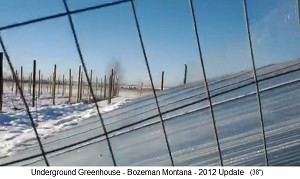
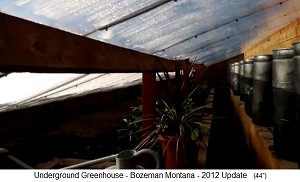
Pit greenhouse in Bozeman, Montana (Canada) - Interior view with ditch for cold air during the night and water barrel heating 1,2

Pit greenhouse in Bozeman in Montana (Canada) with cold ditch with indentations for the accessibility of the plants - here also pepper plants grow in winter when it is below 0ºC outside [54]
Here is the video:
Video: Underground Greenhouse - Bozeman Montana - 2012 Update (2'17'')
Video: Underground Greenhouse - Bozeman Montana - 2012 Update (2'17'')
https://www.youtube.com/watch?v=w1Aoj0QXrLM
4) Added pit greenhouses attached to the residential home
Attached pit greenhouses with a stonewall as back wall are also very energy efficient with a stone wall as warmth battery.
4a) Cultivated pit greenhouse with arched roof by Rob Stout, Embudo, New Mexico ("USA")
Cultivated pit greenhouse with a Plexiglas roof in the shape of a semi-U by Rob Stout, Embudo, New Mexico ("USA")
The adding of a pit greenhouse is also efficient because the residential home is like an insulated body without extreme cold nor extreme heat. One can increase the heat painting the wall and the structures in a dark color or even in black because with black color the walls and structures are warming most. Combined with a permaculture raised bed there can grow also tropical plants here.
Pit greenhouse attached to the main house. Designed by Rob Stout, Southwest Solar Design, Embudo, New Mexico. The glazing is a polycarbonate 7/8" polycarbonate panel. This panel bends by itself without any problem. Also note the ventilation windows below.
(from: http://lloydkahn-ongoing.blogspot.pe/2011/02/adobepolycarbonate-greenhouse-in-new.html)
4b) Cultivated mine greenhouse with full glazing in white
Attached pit greenhouse in white. From solarinnovations.com. (In 2018 the website is unfortunately not there anymore).
[White is the sacred color of the fake virgins in the criminal church. White is the least favorable color to store heat, because the color white reflects heat and repels heat. So this pit greenhouse should get another color like green, brown or red, at least beige].
The construction is 100% susceptible to hail damage.
4c) Attached pit greenhouse with full glazing in black
Cultivated pit greenhouse in black as an extension of a residential home being added to a raw stone wall - this is very energy efficient. Of solarinnovations.com. (2018 this web site does not exist any more).
[Black is the color that stores heat the most].
The construction is 100% susceptible to hailstorm.
5) Straw ball greenhouses / hothouses
Straw bales are a good insulator (an R value of 1.5 to 3 per inch). Underground fertilizer will also help to keep these plants warm. Photo by Terrie Schweitzer, via flickr.
========
This small hothouse consists of straw bales and old windows. Compost and fertilizer under the top layer keep the area warm.
[According to permaculture, only compost should be used, which strengthens the plants. Fertilizer provokes weaker plants].
Links about pit greenhouses
The partially-submerged YMCA Solar Greenhouse in Blacksburg, Virginia.
A clearinghouse of info on solar greenhouses from L. David Roper.
Mike Oehler’s Earth Sheltered Greenhouse.
Photos of underground greenhouse construction in Kyrgyzstan.
How Joseph Orr built a mud heat-storage solar greenhouse that even heats an adjacent room.
A step-by-step look at building a cinder block underground greenhouse.
Photos of a bermed, solar-heated greenhouse in Southern Idaho.
Step-by-step construction photos of a small, earth-sheltered greenhouse.
Step-by-step instructions and designs for a quonset hut style greenhouse made from chain link fence top railings. You’ll need a lot of land for this one.
If you’re okay with this, here’s how to build a greenhouse that’s heated by an adjacent chamber of compost.
What life is like at the Solviva greenhouse, where it’s 4 degrees outside but, inside the greenhouse, you can be plucking fresh tomatoes in 75-degree heat.
Best books with instructions for building of pit greenhouses / pit hothouses
The Earth Sheltered Solar Greenhouse Book by Mike Oehler
Solviva: How To Grow $500,000 On One Acre by Anna Edey
The Winter Harvest Handbook: Year Round Vegetable Production Using Deep-Organic Techniques and Unheated Greenhouses by Eliot Coleman
Solar Greenhouses Underground by Daniel Geery
The Solar Greenhouse Book by James McCullagh
Gardener’s Solar Greenhouse: How to Build and Use a Solar Greenhouse for Year-Round Gardening by Ray Wolf
More sources about pit greenhouses / pit hothouses
National Center For Appropriate Technology: Learn about slope, orientation, glazing, etc
Solar Greenhouses: Lots of info here by L. David Roper!
Compost heated greenhouses: Provided by the National Center For Appropriate Technology
Cedar Built Greenhouses: Wood greenhouse kits, they will make a kit for your foundation
Build It Solar: For other solar greenhouse links
Pit greenhouse, video
(This is part 1 of 34 (so far)!)
========
Nov. 4, 2015: Build yourself a frost free underground greenhouse
(original German: Ein kältefestes unterirdisches Gewächshaus bauen) [web02]
https://www.zamnesia.com/de/blog-ein-kaltefestes-unterirdisches-gewachshaus-bauen-n787
Translation:
<Build your own
A massive pit in the garden may not be discreet, but it can be a small, well-planned one. Since the basic principles behind the construction remain the same regardless of size, a pit greenhouse can be adapted to any situation and the good news is that they are fairly inexpensive to install; all you need is time and a lot of effort.
You need:
-- Energy, willpower and the ability to work hard with the hands
-- A roof
-- Earth to build
The basic principle is to dig a rectangle of at least 2.5 meters depth (if you want to raise high species also deeper). The width and length of the rectangle do not matter, but should be large enough to comfortably accommodate many plants (and possibly a some food depots).
The length of the rectangle (the longest area) should be dug to point towards the winter sun - to the south in the northern hemisphere - and when you live in the southern hemisphere, to the north.
On the opposite [shadow] side, you will then pile up a higher mound, followed by a smaller mound at the front (the long sunny side). This creates a nice slope on which you can put on the roof. For optimum sunshine effect, the roof should run down from the larger wall at an angle of 39 degrees.
Once this is done, you'll pull all sides of the rectangle up to walls to create a completely enclosed pit.>
[And install stairs with an intrence].
| Share: |
Facebook |
|
Twitter
|
|
|
|
Photo sources
Walipini, vegetable field in a pit greenhouse half underground with earth warmth where it's never under 0ºC:
www.facebook.com/gmofreeusa - www.gmofreeusa.org







^
